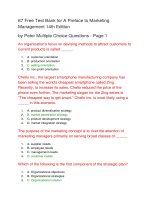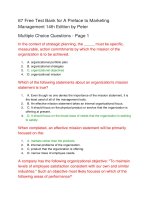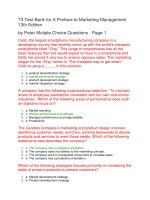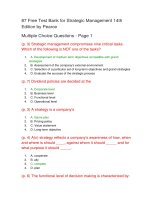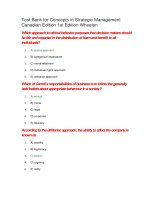Test bank of fred r david – strategic management, 13th edition ch07
Bạn đang xem bản rút gọn của tài liệu. Xem và tải ngay bản đầy đủ của tài liệu tại đây (100.55 KB, 36 trang )
Exam
Name___________________________________
TRUE/FALSE. Write 'T' if the statement is true and 'F' if the statement is false.
1)
An organization's present strategies, objectives and mission provide a basis for generating and evaluating
feasible alternative strategies, coupled with the external and internal audit information.
1)
_______
2)
A sustainability report provides information on a firm's social-responsibility practices.
2)
_______
3)
Sustainability is the idea that a business can meet its financial goals without hurting customers.
3)
_______
4)
The first stage of the strategy-formulation framework (the input stage), is followed by the decision stage.
4)
_______
5)
Stage 2 in the strategy-formulation framework involves the Quantitative Strategic Planning Matrix.
5)
_______
6)
Good intuitive judgment is always needed to determine appropriate weights and ratings in the input stage
matrices.
6)
_______
7)
The Strengths-Weaknesses-Opportunities-Threats (SWOT) Matrix, the Strategic Position and Action
Evaluation (SPACE) Matrix, the Boston Consulting Group (BCG) Matrix, the Internal-External (IE) Matrix and
the Grand Strategy Matrix are included in stage two of the strategy-formulation framework.
7)
_______
8)
When completing the matching stage of the strategy-formulation framework, the SWOT Matrix needs to be
completed before the SPACE Matrix.
8)
_______
9)
The purpose of matching key factors is to generate feasible alternative strategies.
9)
_______
10)
Strengths-opportunities strategies are based on using a firm's internal strengths to take advantage of
external opportunities and threats.
10)
______
11)
A SWOT Matrix is composed of four cells for the four types of strategies it creates.
11)
______
12)
One of the steps of the SWOT Matrix is to list the firm's key external opportunities.
12)
______
13)
The SWOT matrix is widely used as an organizational tool and, if used appropriately, does not have any
significant weaknesses.
13)
______
14)
The most important determinants of an organization's overall strategic position are considered to be the
two internal dimensions, financial strength (FS) and competitive advantage (CA), and the two external
dimensions, industry strength (IS) and environmental stability (ES).
14)
______
15)
The four strategies of the SPACE Matrix are aggressive, conservative, offensive and defensive.
15)
______
16)
Market penetration can be classified as either a conservative, aggressive, or competitive strategy.
16)
______
17)
The ES and CA dimension variables in a SPACE Matrix are assigned a numerical value ranging from -1
(best) to -6 (worst).
17)
______
18)
Conservative strategies in a SPACE Matrix most often include product development, market development,
market penetration and concentric diversification.
18)
______
19)
The firm should pursue conservative strategies if the coordinates of a SPACE directional vector are (1,4).
19)
______
20)
A firm should pursue defensive strategies if the coordinates of a SPACE directional vector are (2,3).
20)
______
21)
The firm should pursue aggressive strategies if the coordinates of a SPACE directional vector are (5,4).
21)
______
22)
Relative market share position is given on the x-axis of the BCG Matrix.
22)
______
23)
The midpoint on the x-axis of a BCG Matrix is typically set at 0.05.
23)
______
24)
The size of the circle in a BCG Matrix corresponds to the proportion of corporate revenue generated by that
business unit.
24)
______
25)
In a BCG Matrix, the pie slice indicates the proportion of corporate profits generated by that division.
25)
______
26)
Star, question mark, cash cow and dogs are the four quadrants exhibited by the SPACE Matrix.
26)
______
27)
Cash cows represent the organization's best long-run opportunities for growth and profitability.
27)
______
28)
The major overall benefit of the BCG Matrix is that it draws attention to the cash flow, investment
characteristics and needs of an organization's various divisions.
28)
______
29)
Viewing businesses as star, cash cow, dog or question mark is an oversimplification.
29)
______
30)
The BCG Matrix does not reflect whether or not various divisions or their industries are growing over time.
30)
______
31)
Having no temporal qualities, the BCG Matrix is a snapshot of an organization at a given point in time.
31)
______
32)
Both IE and BCG Matrices are called portfolio matrices.
32)
______
33)
BCG Matrix requires more information about the divisions than the IE Matrix.
33)
______
34)
On the x-axis of the IE Matrix, an internal factor evaluation score of 2.5 represents a weak internal position.
34)
______
35)
The IE Matrix can be divided into three major regions that have different strategy implications grow and
build, hold and maintain, and harvest or divest.
35)
______
36)
The Grand Strategy Matrix is based on two evaluative dimensions, market share and market growth.
36)
______
37)
According to the Grand Strategy Matrix, when a Quadrant I firm is too heavily committed to a single
product, then concentric diversification may reduce the risks associated with a narrow product line.
37)
______
38)
According to the Grand Strategy Matrix, Quadrant III organizations compete in rapid-growth industries and
have weak competitive positions.
38)
______
39)
To objectively evaluate feasible alternative strategies identified in Stage 2, the QSPM uses input
information derived from Stage 1.
39)
______
40)
Step 1 of a QSPM assigns weights to each key external and internal factor.
40)
______
41)
Total attractiveness scores are defined as the sum of the attractiveness scores in a given column of the
QSPM and are computed in the second step of the QSPM.
41)
______
42)
A positive feature of QSPM is that sets of strategies can be examined sequentially or simultaneously.
42)
______
43)
One positive feature of QSPM is that it does not require intuitive judgments and educated assumptions.
43)
______
44)
Culture includes the set of shared values, beliefs, attitudes, customs, norms, personalities, heroes and
heroines that describe a firm.
44)
______
45)
Strategy changes may be highly effective and productive if a supportive culture does not exist.
45)
______
46)
Whenever two firms merge, it becomes especially important to evaluate and consider culture-strategy
linkages.
46)
______
47)
Successful strategists minimize their own political exposure on issues that are highly controversial, and in
circumstances where opposition from major power centers is likely.
47)
______
48)
Focusing on Higher-Order Issues means it is often possible to achieve similar results using different means
or paths.
48)
______
49)
Shifting focus from specific issues to more general ones may increase strategists' options for gaining
organizational commitment.
49)
______
50)
The trend in many Arab states is towards greater board member accountability, with larger boards
averaging 18 members.
50)
______
51)
Boards of directors are composed mostly of outsiders who are becoming more involved in an organization's
strategic management.
51)
______
52)
The Sarbanes-Oxley Act put an end to the "country-club" atmosphere of most boards, and has shifted
power from CEOs to directors.
52)
______
MULTIPLE CHOICE. Choose the one alternative that best completes the statement or answers
the question.
53)
Strategy analysis and choice largely involves making ________ decisions based on ________ information.
53)
______
A)
long-term; short-term
B)
subjective; short-term
C)
subjective; objective
D)
objective; subjective
E)
short-term; long-term
54)
Which stage in the strategy-formulation framework focuses on generating feasible alternative strategies?
54)
______
A)
Output
B)
Input
C)
Matching
D)
Decision
E)
Throughput
55)
Which stage of the strategy-formulation framework involves the Quantitative Strategic Planning Matrix?
55)
______
A)
Stage 4
B)
Stage 1
C)
Stage 2
D)
Stage 3
E)
Stage 5
56)
Which strategy formulation technique reveals the relative attractiveness of alternative strategies, and thus
provides an objective basis for selecting specific strategies?
56)
______
A)
SWOT
B)
SPACE
C)
IFE
D)
QSPM
E)
CPM
57)
Each of the nine techniques included in the strategy formulation framework rely on the use of
57)
______
A)
financial formulas and statistics.
B)
intuition and analysis.
C)
luck.
D)
synergy.
E)
strictly factual data.
58)
Which stage of the strategy formulation framework includes an Internal Factor Evaluation Matrix and a
Competitive Profile Matrix?
58)
______
A)
Decision
B)
Research
C)
Penetration
D)
Input
E)
Matching
59)
Which stage of the strategy formulation framework contains the Internal-Factor Evaluation Matrix?
59)
______
A)
Output
B)
Matching
C)
Analysis
D)
Input
E)
Decision
60)
The match an organization makes between its internal resources and skills, and the opportunities and risks
created by its external factors, can be defined as
60)
______
A)
input.
B)
strategy.
C)
concept formulation.
D)
an opportunity.
E)
SWOT.
61)
Which section of the SWOT Matrix involves matching internal strengths with external opportunities?
61)
______
A)
The ST cell
B)
The SW cell
The SO cell
C)
D)
The WO cell
E)
The WT cell
62)
Which strategies, defined by the SWOT matrix, aim at improving internal weaknesses by taking advantage
of external opportunities?
62)
______
A)
SO
B)
SW
C)
WO
D)
WT
E)
ST
63)
Which strategies, defined by the SWOT matrix, use a firm's strengths to avoid or reduce the impact of
external threats?
63)
______
A)
SW
B)
SW
C)
ST
D)
WO
E)
WT
64)
Which strategies, defined by the SWOT matrix, are defensive tactics directed at reducing internal
weaknesses and avoiding environmental threats?
64)
______
A)
ST
B)
SO
C)
WO
D)
WT
E)
SW
65)
How many cells are in a SWOT Matrix?
65)
______
A)
Four
B)
Eight
C)
Six
D)
Two
E)
Nine
66)
Which of the following is not a step of a SWOT Matrix?
66)
______
A)
List the firm's external weaknesses.
B)
List the firm's key external threats.
C)
Match internal weaknesses with external threats and record the resultant WT strategies.
D)
Match strengths with external opportunities and record the resultant SO strategies in the appropriate cell.
E)
List the firm's external opportunities.
67)
Which of the following is a weakness associated with a SWOT Matrix?
67)
______
A)
Other variables besides relative market share position and industry growth rate in sales need to be
considered.
B)
Many businesses fall right in the middle of the matrix.
C)
Viewing every business as a Star, Cash Cow, Dog, or Question Mark is an oversimplification.
D)
The matrix does not reflect whether or not various divisions or their industry are growing over time.
E)
The matrix has no temporal qualities.
68)
Which of these is not a SPACE Matrix quadrant?
68)
______
A)
Competitive
B)
Defensive
C)
Offensive
D)
Conservative
E)
Aggressive
69)
What type of strategy would divestiture be classified as?
69)
______
A)
Aggressive
B)
Conservative
C)
Competitive
D)
Offensive
E)
Defensive
70)
The two internal dimensions represented on the axes of the SPACE Matrix are
70)
______
A)
industry strength and internationalization.
B)
financial strength and environmental stability.
C)
competitive advantage and financial strength.
D)
environmental stability and industry strength.
E)
internationalization and competitive advantage.
71)
What are the two external dimensions of the SPACE Matrix?
71)
______
A)
Competitive advantage and financial strength
B)
Environmental stability and competitive advantage
C)
Industry strength and competitive advantage
D)
Environmental stability and industry strength
E)
Financial strength and industry strength
72)
The two positive-rated dimensions on SPACE Matrix are
72)
______
A)
CA and ES.
B)
FS and CA.
C)
FS and ES.
D)
FS and IS.
E)
IS and ES.
73)
What type of strategies would you recommend when a firm's SPACE Matrix directional vector has the
coordinates (-2, +3)?
73)
______
A)
Defensive
B)
Conservative
C)
Competitive
D)
Aggressive
Integrative
E)
74)
In a SPACE analysis, what does a (+6, +3) strategy profile portray?
74)
______
A)
A weak financial position
B)
A weak industry
C)
A stable environment
D)
A strong industry
E)
An unstable environment
75)
For what type of company is the BCG Matrix ideal for analyzing?
75)
______
A)
Large companies
B)
Companies with annual sales greater than $1 million
C)
Companies with annual sales of less than $1 million
D)
All companies
E)
Companies with more than one division
76)
In the BCG Matrix, which element represents the industry growth rate in sales, measured in percentage
terms?
76)
______
A)
First quadrant
B)
Third quadrant
C)
x-axis
D)
Second quadrant
E)
y-axis
77)
How would a division with a low relative market share position in a high growth industry be described?
77)
______
A)
Stuck-in-the-middle
B)
Question mark
C)
Cash cow
D)
Dog
E)
Star
78)
When a division of an organization has a high relative market share and is in a fast-growing industry, it is
called a
78)
______
A)
star.
B)
question mark.
C)
dog.
D)
cash cow.
E)
cat.
79)
A division with a high relative market share position in a low-growth industry can be described as a
79)
______
A)
failure.
B)
cash cow.
C)
dog.
D)
star.
E)
question mark.
80)
Which strategy would be most appropriate for a company classified as a Dog?
80)
______
A)
Market development
B)
Retrenchment
C)
Market penetration
D)
Forward integration
E)
Product development
81)
Which of the following is likely to have been a cash cow in the past?
81)
______
A)
Question mark
B)
Cat
C)
Dog
Failure
D)
E)
Star
82)
An organization that has a low relative market share position and competes in a slow-growth industry is
referred to as a
82)
______
A)
star.
B)
cowboy.
C)
dog.
D)
cash cow.
E)
question mark.
83)
The limitations of a BCG Matrix include all of these except
83)
______
A)
not allowing a company to be classified as somewhere in between two categories.
B)
other variables such as size of market and competitive advantage are not considered.
C)
viewing every business as a star, cash cow, dog or question mark can be an oversimplification.
D)
requiring at least three years' worth of data.
E)
not reflecting divisional or industry growth over time.
84)
Which of the following analytical tools consists of a nine-cell matrix?
84)
______
A)
SPACE Matrix
B)
Matching Matrix
C)
Competitive Profile Matrix
D)
Internal-External Matrix
E)
Grand Strategy Matrix
85)
What analytical tool has four quadrants based on two dimensions competitive position and market growth?
85)
______
A)
QSPM
B)
SPACE Matrix
C)
Grand Strategy Matrix
D)
Internal-External Matrix
E)
Competitive Profile Matrix
86)
Which quadrant of the Grand Strategy Matrix contains firms that are in an excellent strategic position?
86)
______
A)
V
B)
II
C)
III
D)
IV
E)
I
87)
According to the Grand Strategy Matrix, which strategy is recommended for a firm with rapid market
growth and a strong competitive position?
87)
______
A)
Retrenchment
B)
Joint venture
C)
Conglomerate diversification
D)
Liquidation
E)
Market penetration
88)
For companies located in Quadrant III of the Grand Strategy Matrix, the first strategy recommended is
88)
______
A)
immediate liquidation of assets.
B)
divestiture.
C)
asset expansion.
D)
employee expansion.
E)
extensive cost and asset reduction.
89)
According to the Grand Strategy Matrix, although Quadrant ________ companies are growing, they are
unable to compete effectively, so they need to determine why the firm's current approach is ineffective
and how the company can best change to improve its competitiveness.
89)
______
A)
I
B)
II
C)
IV
D)
V
E)
III
90)
According to the Grand Strategy Matrix, organizations in which quadrant have a strong competitive
position but are in a slow-growth industry?
90)
______
A)
I
B)
III
C)
IV
D)
II
E)
V
91)
Which matrix is included in the decision stage of the strategy formulation framework?
91)
______
A)
SPACE Matrix
B)
Grand Strategy Matrix
C)
BCG Business Portfolio Matrix
D)
Internal Factor Evaluation Matrix
E)
Quantitative Strategic Planning Matrix
92)
The top row of a Quantitative Strategic Planning Matrix consists of alternative strategies derived from all of
these except
92)
______
A)
Space Matrix.
B)
CPM Matrix.
C)
BCG Matrix.
D)
IE Matrix.
E)
Grand Strategy Matrix.
93)
Which analytical tool determines the relative attractiveness of various strategies based on the extent to
which key external and internal critical success factors are capitalized?
93)
______
A)
IE
B)
SPACE
C)
BCG
D)
TOWS
E)
QSPM
94)
Which of the following is the first step in developing the QSPM?
94)
______
A)
Compute the Total Attractiveness Scores.
B)
Assign weights to each key external and internal factor.
C)
Determine the Attractiveness Scores.
D)
Examine the Stage 2 matrices and identify the alternative strategies which the organization should
consider implementing.
E)
Make a list of the firm's key external opportunities/threats and internal strengths/weaknesses in the left
column of the QSPM.
95)
What term is defined as the product of multiplying the weights by attractiveness scores in each row of the
QSPM?
95)
______
A)
Weighted scores
B)
Factors
C)
Total weighted scores
D)
Sum total attractiveness scores
E)
Total attractiveness scores
96)
What is the highest number of strategies that can be examined at one time with the QSPM?
96)
______
A)
2

